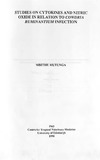| dc.description.abstract | This thesis describes studies on the pathogenesis of heartwater by investigating
the effects of cytokines and nitric oxide (NO) in experimental Cowdria ruminantium
infections in in vitro and in vivo models. The latter were carried out in sheep and mice.
In sheep infections, there was increased levels of antioxidation enzymes,
glutathione peroxidase and superoxide dismutase with the highest levels coinciding with
the period of the clinical disease. C. ruminantium was also found to induce increased
levels of nitrite, indicative of NO, in plasma where the nitrite levels were found to have
an earlier and higher increase in sheep with prior exposure to C. ruminantium antigens
as compared to naive sheep infections. Mean interferon gamma (IFN-y) levels in
plasma were found to be increased after infection just prior to or at time of the febrile
reaction, with higher levels being recorded in the sheep with prior exposure to C.
ruminantium antigens than in the naive animals. There was a gradual increase in mean
interleukin 8 (IL-8) and tumor necrosis factor alpha (TNF-a.) levels after infection and
the highest levels coincided with the febrile reaction. Higher levels of IL-8 were
recorded in the primary infections than in the sheep with prior exposure to C.
ruminantium antigens.
To determine the source of the NO detected in in vivo studies, in vitro studies
of C. ruminantium infections of bovine pulmonary endothelial cells (BPEC) were
conducted and NO was found to be induced by C. ruminantium infections. The NO
production was found to be enhanced by bovine recombinant IFN-y and was inhibited
by nitric oxide inducible synthase inhibitor, LNMMA. Induction of apoptotic cell death
was seen in IFN- y treated cells with the infected cells showing higher apoptotic cell
death than the uninfected cells. Treatment of elementary bodies with NO was found to
reduce both infectivity and viability of C. ruminantium. This indicates that NO is
released during endothelial infection and has an effect upon infectivity and viability of
the organism.
The importance of interferons in the control of C. ruminantium infections was
further investigated in an in vivo model using mice deficient in IFN- Y and IFN-a/b
receptors. Infection of these mice resulted in a more severe disease characterised by a
shorter incubation period, higher morbidity and mortality rates in relation to time, with
more pronounced pathology characterised by increased amount of oedema fluid,
infiltration of inflammatory cells and higher lung and brain infection rate as compared to
control mice. Electron micrographs from infected mice 7 days post-infection indicated
that organisms had developed to later developmental stages in the mice deficient in
IFN- Y receptors, where as earlier developmental forms were seen in controls, with
mixed stages being seen in the IFN-a/13 receptor deficient mice.
Studies then looked at the time course of cytokine production in relation to C.
ruminantium infection in mice. Infection of mice with C. ruminantium induced
transient productions of IFN-y and the biologically active 70 kDa heterodimeric form
ofIL-l2, (IL-l2p70) and a corresponding initial reduction in IL-4 and IL-lO levels. ILl2p70
levels were highest on days 2-4 while IFN-y levels were highest on day 6, just
prior to disease onset followed by a dramatic reduction which also coincided with the
clinical onset on day 8. Levels of IL-4 and IL-lO were reduced immediately after C.
ruminantium infection with the lowest levels coinciding with the highest IFN-y levels
on day 6 post-infection. This study showed induction of a transient Th 1 immune
response which was not sustained, possibly resulting in the fatal outcome of infection of
nnce.
In contrast, inoculations of mice with murine recombinant interleukin 12 (MrIL-
12) were found to have immunomodulatory effects on C. ruminantium infections in
mice and to protect a significant number of mice. The highest protection was afforded
by mice inoculated with MrIL-12 from beginning of infection with booster doses every
2 days; 20% of these did not show any clinical signs and were immune to challenge
infection with an overall recovery rate of 45% as compared to the control. There was
reduction of mortality and morbidity rates in mice inoculated with MrIL-12 before or at
time of infection but giving IL-12 after disease onset was found not to offer any
protection to the animals against C. ruminantium infection. The increased resistance or
reduced severity of infection coincided with sustained increase in IFN- y, nitrite levels
and in IgG2a immunoglobulins and a reduction in IL-4 and IL-l O.
This study showed that the course taken by C. ruminantium infection in both
in vivo and in vitro models is dependent on the cytokine and antibody milieu in
plasma and possibly tissues prior to or during infection. Involvement of NO in C.
ruminantium infections was suggested in this study. Infection in mice was
characterised by a transient high IFN-y response at about day 6 which was not
sustained. It is likely that this response controls C. ruminantium to some extent
because mice deficient in IFN-y receptors died earlier in the disease with higher
infection levels as compared to the control. Sustained release oflFN-y occurred in
mice treated with MrIL-12 and provided protection in a significant proportion. The
failure to sustain IFN -y in mice may be related to a lack of sustainable IL-12
production.
The importance of a Th 1 type immune response was, therefore, underlined and
the possible roles for IL-12 and IFN- y with involvement of nitric oxide in the killing of
the infectious agent suggested. The study showed for the first time the possible roles of
nitric oxide in the killing immune response and pathology of the disease and the
importance of availability of IL-12 early in infection in the development of protective
. . . nnmune response m mice. | en |

